1 Introduction of Seam Sealing Tapes Types
According to the types, seam sealing tapes can be divided into 3-Layer, 2-Layer, 1-Layer, and others.
3-Layer is similar to 2-layer seam sealing tapes but with a thicker and more heavy-duty design that makes them ideal for use in more demanding environments such as military applications, medical wear, the automotive industry (for the likes of car seat seam sealing and dashboards), dry and wet suits and PPE Clothing.
2-Layer seam sealing tape is commonly used to prevent water penetration over stitch seams and is commonly found in the likes of waterproof jackets.
Single layer seam sealing tapes are only activated by heat to weld onto PU coated fabrics.
2 Global Seam Sealing Tapes Market Value by Type
From 2018 to 2023, the global market value of different types of seam sealing tapes has shown varying trends. Single-layered tapes have seen a steady increase from 30.69 M USD in 2018 to an estimated 36.89 M USD in 2023. Two-layered tapes have also experienced growth, rising from 71.22 M USD in 2018 to a forecasted 93.64 M USD in 2023. Three-layered tapes have shown the most significant growth, starting at 130.76 M USD in 2018 and projected to reach 166.81 M USD by 2023.
Comparing the types, three-layered tapes have the highest market value and are projected to continue this trend, while single-layered tapes have the lowest market value and are expected to maintain a steady growth. Two-layered tapes are positioned in the mid-range and are also expected to continue their growth trajectory.
Table Global Seam Sealing Tapes Value (M USD) by Type (2018-2023)
|
|
2018 |
2019 |
2020 |
2021 |
2022 |
2023F |
|
Single-layered |
30.69 |
32.27 |
31.42 |
34.20 |
35.45 |
36.89 |
|
Two-layered |
71.22 |
76.59 |
75.30 |
82.79 |
87.67 |
93.64 |
|
Three-layered |
130.76 |
138.36 |
136.77 |
151.16 |
158.07 |
166.81 |
|
Others |
11.59 |
12.41 |
12.23 |
13.68 |
14.32 |
15.24 |
|
Total |
244.26 |
259.63 |
255.73 |
281.83 |
295.51 |
312.57 |
3 Global Seam Sealing Tapes Market Value Share by Type
From 2018 to 2023, the market share of different types of seam sealing tapes has slight variations. Single-layered tapes have seen a slight decrease in their market share from 12.56% in 2018 to 11.80% in 2023.
Two-layered tapes have experienced a slight increase from 29.16% in 2018 to 29.96% in 2023. Three-layered tapes have seen a minor fluctuation, starting at 53.53% in 2018 and projected to be 53.37% in 2023.
Figure Global Seam Sealing Tapes Value Share by Type (2018-2023)
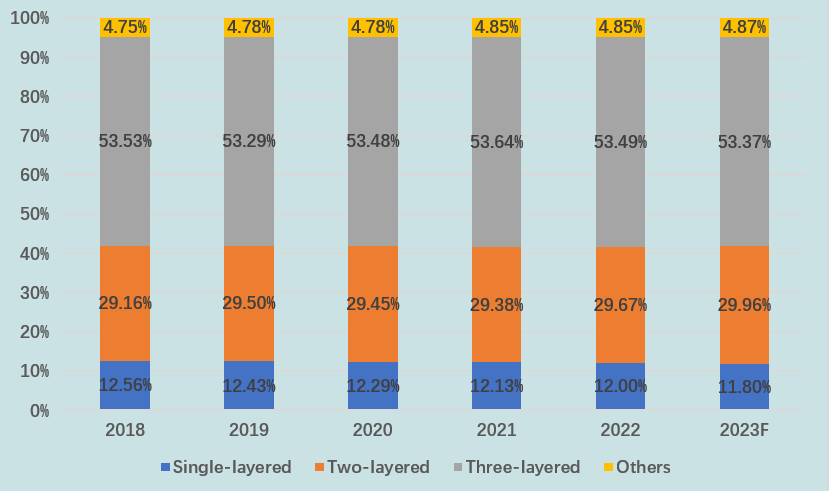
4 Global Seam Sealing Tapes Value Market Share by Types in 2022
In 2022, the market share for each type of seam sealing tapes was as follows: Single-layered held 12.00%, Two-layered accounted for 29.67%, Three-layered had the largest share at 53.49%, and Others made up the remaining 4.85%.
Comparing the types, three-layered tapes consistently hold the largest market share, indicating a preference for their durability and suitability for demanding applications. Two-layered tapes follow closely, showing a slight growth trend, while single-layered tapes have the smallest market share, reflecting their more niche use.
Figure Global Seam Sealing Tapes Value Market Share by Types in 2022
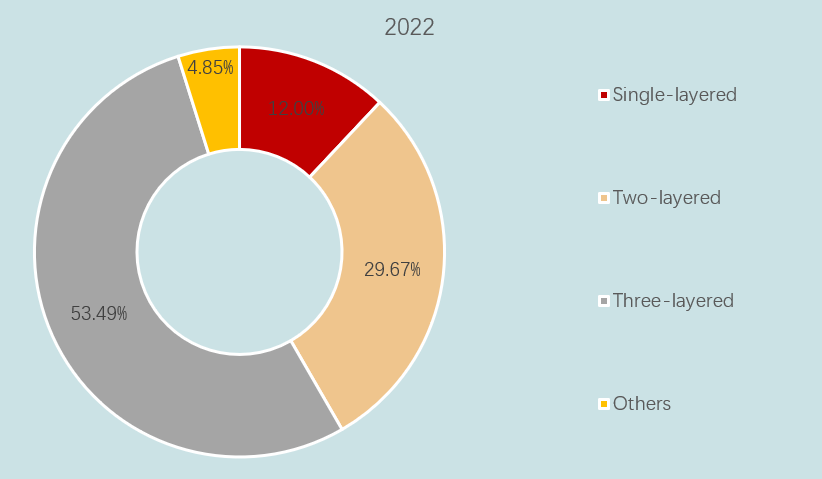
5 Global Seam Sealing Tapes Market Price Analysis by Type
In 2023, there is a large difference in the price of each type of seam sealing tape. Single-layered tapes were priced at 63.3 USD per meter. Two-layered tapes were priced at 103.9 USD per meter. Three-layered tapes were priced at 197.0 USD per meter.
The three-layered tapes had the highest price, indicating their suitability for more demanding applications, while single-layered tapes had the lowest price, reflecting their use in less demanding environments.
Figure Global Seam Sealing Tapes Price (USD/Meter) by Type (2018-2023)
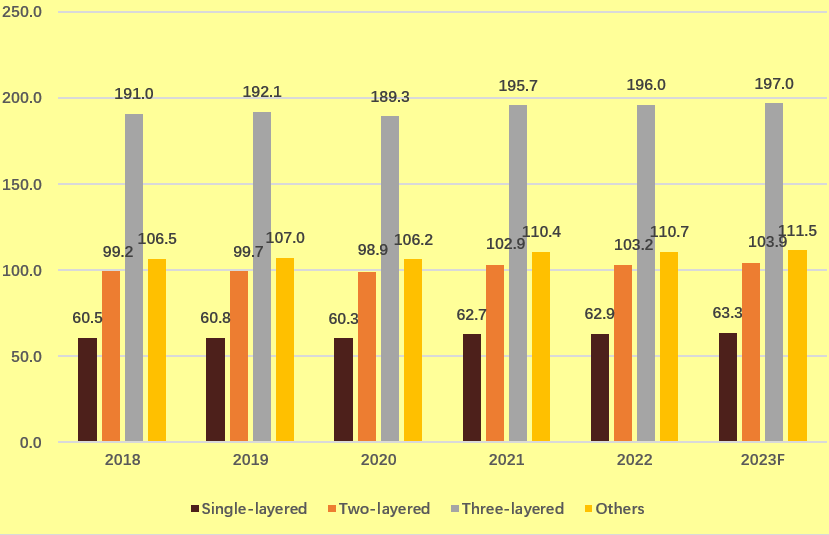
6 Introduction of Seam Sealing Tapes Applications
Seam sealing tape is simply a type of tape used to coat fabrics (Apparels, Tents, Tarpaulins, Footwear, Backpacks, etc.). To prevent moisture and water penetration, while increasing the strength of the product joints. For example, outdoor clothing, such as waterproof jackets, fishing gear, etc. Sports clothing, waterproof boots and other footwear, camping tents, sleeping bags and rucksacks/backpacks, wet wetsuits, dry wetsuits and diving gear, military uniforms, backpacks, vests, helmets and other equipment, personal protective equipment including masks, robes, suits, etc. It can also be used to seal car seats.
7 Global Seam Sealing Tapes Market Consumption Volume (Million Meters) Segment by Applications
The consumption volume of seam sealing tapes across various applications from 2018 to 2023 shows a general upward trend. For instance, the apparels sector saw an increase from 1023.54 million meters in 2018 to a forecasted 1246.06 million meters in 2023. Tents experienced growth from 303.77 million meters to an expected 376.63 million meters. Tarpaulins, while starting from a lower base of 33.91 million meters, are projected to reach 40.59 million meters by 2023. Footwear’s consumption rose from 390.76 million meters to an anticipated 480.23 million meters. Backpacks also showed an increase from 106.98 million meters to a forecasted 123.59 million meters. The ‘Others’ category grew from 159.45 million meters to an expected 200.22 million meters. The total consumption volume increased from 2018.41 million meters in 2018 to a projected 2467.32 million meters in 2023.
Comparatively, apparels consistently had the highest consumption volume throughout the period, with a significant lead over other applications. Footwear was the second-largest consumer, with its consumption volume nearly half that of apparels. Tents and backpacks had moderate consumption volumes, with tents being slightly higher. Tarpaulins had the lowest consumption volume, but it still showed a steady increase. The ‘Others’ category, while not as high as the top three applications, also contributed significantly to the total consumption volume and experienced growth over the years.
Figure Global Seam Sealing Tapes Consumption Volume (Million Meters) Segment by Applications from 2018-2023
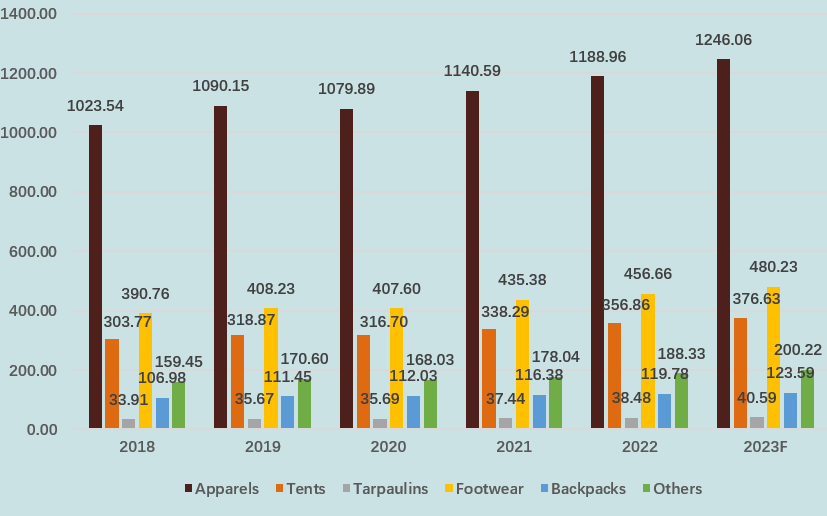
8 Global Seam Sealing Tapes Market Consumption Share by Applications in 2022
In 2022, the global seam sealing tapes market was dominated by the apparels sector, which held the largest share at 50.61%. The footwear industry followed with a significant share of 19.44%. Tents and backpacks also had notable market shares, accounting for 15.19% and 8.02%, respectively. Tarpaulins and others captured smaller portions of the market, with 5.10% and 1.64%, respectively. This distribution highlights the diversity of applications for seam sealing tapes and the importance of the apparels sector within the market.
Figure Global Seam Sealing Tapes Market Share by Applications in 2022
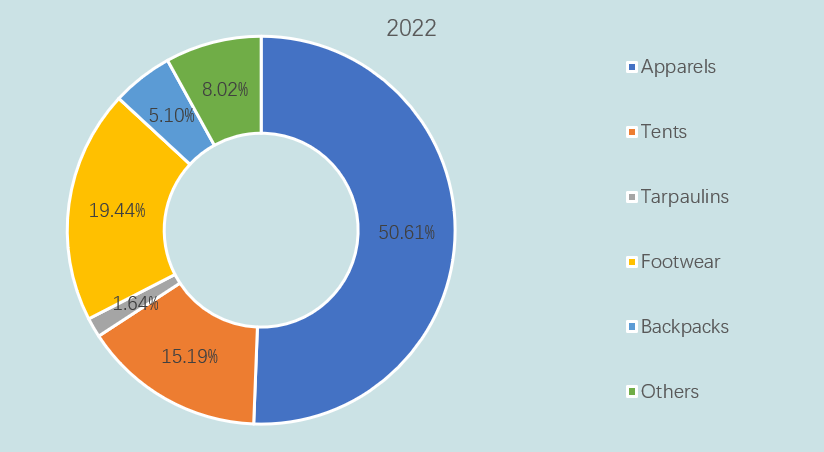
9 Global Seam Sealing Tapes Market Volume (Million Meters) Forecast by Application
From 2023 to 2028, the market consumption volume for seam sealing tapes is projected to increase across all applications. Apparels are expected to see the most significant growth, rising from 1246.06 million meters in 2023 to 1591.05 million meters in 2028. Tents will increase from 376.63 million meters to 483.33 million meters, while tarpaulins will grow from 40.59 million meters to 50.02 million meters. Footwear’s consumption is forecasted to rise from 480.23 million meters to 597.39 million meters. Backpacks will see an increase from 123.59 million meters to 154.92 million meters, and the ‘Others’ category will grow from 200.22 million meters to 244.80 million meters. The total market volume is expected to expand from 2467.32 million meters in 2023 to 3121.49 million meters in 2028.
Comparatively, the apparels sector will continue to dominate the market, with its consumption volume significantly higher than other applications throughout the forecast period. Footwear will remain the second-largest consumer, with its volume nearly a third of that of apparels. Tents will have a moderate share, similar to the ‘Others’ category but slightly higher. Backpacks will have a smaller share, with a growth rate that keeps it behind tents and the ‘Others’ category. Tarpaulins, despite their low starting volume, will maintain the smallest share of the market, although they will also experience growth. The overall trend indicates a healthy expansion in the seam sealing tapes market with apparels leading the way.
Table Global Seam Sealing Tapes Market Volume (Million Meters) Forecast by Application (2023-2028)
|
|
2023F |
2024F |
2025F |
2026F |
2027F |
2028F |
|
Apparels |
1246.06 |
1308.49 |
1378.15 |
1443.36 |
1520.75 |
1591.05 |
|
Tents |
376.63 |
394.99 |
414.93 |
436.65 |
458.85 |
483.33 |
|
Tarpaulins |
40.59 |
42.46 |
44.42 |
45.75 |
48.21 |
50.02 |
|
Footwear |
480.23 |
503.77 |
529.37 |
553.73 |
576.87 |
597.39 |
|
Backpacks |
123.59 |
130.38 |
137.45 |
142.18 |
149.14 |
154.92 |
|
Others |
200.22 |
207.43 |
218.53 |
225.34 |
236.12 |
244.80 |
|
Total |
2467.32 |
2587.53 |
2722.85 |
2847.02 |
2989.94 |
3121.49 |
10 Global Seam Sealing Tapes Market Volume Share Forecast by Application
In 2028, the global seam sealing tapes market is forecasted to have a consumption market share distribution where apparels will maintain the largest share at 50.97%. Tents will hold a share of 15.48%, while tarpaulins will have a minimal share of 1.60%. Footwear will account for 19.14% of the market, backpacks for 4.96%, and the ‘Others’ category will have a share of 7.84%. This distribution indicates that apparels will continue to be the primary consumer of seam sealing tapes, with footwear and tents also having significant market shares.
Table Global Seam Sealing Tapes Market Volume Share Forecast by Application (2023-2028)
|
|
2023F |
2024F |
2025F |
2026F |
2027F |
2028F |
|
Apparels |
50.50% |
50.57% |
50.61% |
50.70% |
50.86% |
50.97% |
|
Tents |
15.26% |
15.27% |
15.24% |
15.34% |
15.35% |
15.48% |
|
Tarpaulins |
1.65% |
1.64% |
1.63% |
1.61% |
1.61% |
1.60% |
|
Footwear |
19.46% |
19.47% |
19.44% |
19.45% |
19.29% |
19.14% |
|
Backpacks |
5.01% |
5.04% |
5.05% |
4.99% |
4.99% |
4.96% |
|
Others |
8.12% |
8.02% |
8.03% |
7.92% |
7.90% |
7.84% |
|
Total |
100.00% |
100.00% |
100.00% |
100.00% |
100.00% |
100.00% |





